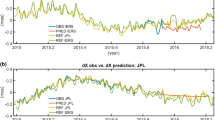Abstract
The straight line concept which has developed as a practical design restriction in intertial surveys with the Litton System is not only cumbersome in the planning stage but also often affects the economy of the survey adversely. A more flexible use of the system is therefore desirable.
The analysis of test data taken along a well-controlledL-shaped traverse near Ottawa indicates that software modifications can eliminate a large part of the errors the to heading sensitivity. The paper discusses the design of an appropriate smoother and ways to find its model structure and its weighting from a series of test runs. Results show that the maximum standard deviation along anL-shaped traverse of100 km length is about half a metre. Further improvements are envisaged by changes in the survey procedures and a more effective use of the filter output. Optimal smoothing is not possible at present and would require a redesign of the filter output.
Sommaire
Le concept de la ligne droite qui a été développé comme une restriction due à la conception du système d’arpentage Litton est non seulement embarrassant au stage de la planification, mais affecte aussi le facteur coût de façon défavorable. Une utilisation plus flexible du système est par conséquent souhaitable.
L’analyse de tests effectués sur un cheminement bien contrôlé en forme deL près d’Ottawa indique que des modifications au logiciel peuvent éliminer la majeure partie des erreurs dues à des changements de direction. La communication discute de la conception d’un lissage approprié et les façons de traiter la structure du modèle et les poids à l’aide d’une série de tests. Les résultats montrent que l’erreur standard maximum dans une traverse en forme deL d’une longueur de100 km, est d’environ0.5 mètre. D’autres améliorations sont envisagées par des changements dans la procédure d’arpentage, et un emploi plus efficace des sorties du filtre. A présent, un lissage optimal n’est pas possible et nécessiterait une reconception des sorties du filtre.
Similar content being viewed by others
References
A. GELB (1974):Applied Optimal Estimation, The M.I.T. Press, Cambridge, Mass. Fourth printing 1978.
J. HANNAH and I.I. MUELLER (1981):Improvement of Inertial Surveys Through Post-Mission Network Adjustment and Self-Calibration. Proceedings of the “Second International Symposium on Inertial Technology for Surveying and Geodesy”, June 1–5, 1981, Banff, Canada.
H.C. HARRIS (1977):DMA operations with an inertial positioning system (IPS). Proceedings of the “1st International Symposium on Inertial Technology for Surveying and Geodesy”, Ottawa.
J. KOUBA (1977):Geodetic Adjustment of Inertial Surveys. Proceedings of the “1st International Symposium on Inertial Technology for Surveying and Geodesy”, Ottawa.
P.B. LIEBELT (1967):An Introduction to Optimal Estimation, Addison-Wesley, Reading, Mass.
K.P. SCHWARZ (1980):Error Propagation in Inertial Positioning. The Canadian Surveyor, vol. 34, pp. 265–276.
K.P. SCHWARZ (1981a):Error Characteristics of Inertial Survey Systems. Invited paper, 16. International Congress of the FIG, Montreux, Switzerland.
K.P. SCHWARZ (1981b):A Comparison of Models in Inertial Surveying. Proceedings of the “Second International Symposium on Inertial Technology for Surveying and Geodesy”, June 1–5, 1981, Banff, Canada.
M.S. TODD (1979):New Experiments and Results in Inertial Surveying at the U.S. Army Engineer Topographic Laboratories. Proceedings of the ACSM, 39th Annual Meeting, Washington, D.C., February 1979.
VON LUETZOW, Baussus H. (1980):On the Advantages and Disadvantages of Local-Level and Space-Stabilized Inertial Platforms under Consideration of Hardware and Software Aspects and Experimental Data. Allgemeine Vermessungs-Nachrichten, vol. 87, pp. 410–421.
G.A. WILKINSON and V.C. WONG (1981):The Use of Azimuth Control in Inertial Surveying to Improve Accuracy on an L-shaped Traverse. Proceedings of the “Second International Symposium on Inertial Technology for Surveying and Geodesy”, June 1–5, 1981, Banff, Canada.
V.C. WONG (1981):A Kalman Filter/Smoother for the Ferranti Inertial Land Surveyor System. Proceedings of the “Second international Symposium on Inertial Technology for Surveying and Geodesy”, June 1–5, 1981, Banff, Canada.
Author information
Authors and Affiliations
Rights and permissions
About this article
Cite this article
Schwarz, K.P., Gonthier, M. Analysis of the heading sensitivity in the Litton inertial survey system. Bull. Geodesique 55, 315–328 (1981). https://doi.org/10.1007/BF02527055
Received:
Accepted:
Published:
Issue Date:
DOI: https://doi.org/10.1007/BF02527055




